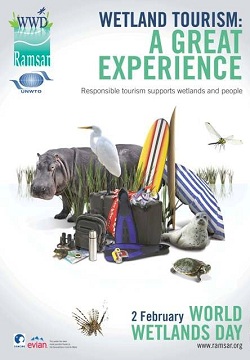World Wetlands Day
Wetlands lie at the interface of terrestrial and aquatic habitats; they possess a unique mixture of species, conditions, and interactions; and are among our planet's most diverse and varied habitats.
2nd February each year is World Wetlands Day.
Wetlands are defined by the soils, hydrology, and species that occur within them.
Wetland soils, also known as hydric soils, are shaped by water. These soils are saturated or even submerged all or part of the year.
Hydric soils vary depending on the composition of the soil and water in the area and therefore, wetlands vary greatly throughout the world.
Wetlands occur in all ecological regions throughout the world except Antarctica.
There are wetlands in the Arctic (which include fens, swamps, marshes, and bogs), wetlands along coastlines (such as mangrove forests, coastal swamps, and tidal marshes), and wetlands throughout inland regions (ponds, marshes, swamps, vernal pools, and riparian systems).
Wetlands are highly productive communities and provide habitat and food resources for a wide range of species.
Wetlands have a high level of nutrients and coupled with the availability of water they provide ideal habitat for fish, amphibians, shellfish, and insects. Additionally, many birds and mammals rely on wetlands for food, water, breeding grounds, and shelter.
World Wetlands Day marks the date of the adoption of the Convention on Wetlands on 2 February 1971, in the Iranian city of Ramsar on the shores of the Caspian Sea.
Each year since 1997, government agencies, non-governmental organizations, and groups of citizens at all levels of the community have taken advantage of the opportunity to undertake actions aimed at raising public awareness of wetland values and benefits in general, and the Ramsar Convention in particular.
The World Wetlands Day theme for 2012 is Wetlands and Tourism and is linked to the theme for the next meeting of the Conference of the Parties, COP11: Wetlands, Tourism and Recreation, which will take place in July 2012, in Bucharest, Romania.
Wetland tourism has benefits both locally and nationally for people and wildlife - benefits such as stronger economies, sustainable livelihoods, healthy people and thriving ecosystems.
At least 35% of Ramsar Sites around the world record some level of tourism activity and this percentage is consistent throughout all regions.
Of course it is important to consider tourism in all wetlands - not just those designated as Ramsar Sites – since the Contracting Parties to the Convention are committed to managing all wetlands.
It is worth noting that tourism is only one of the services that wetlands deliver.
Ensuring well-managed tourism practices in and around wetlands and educating tourists on the value of wetlands contributes to the health of the world's wetlands and the long-term benefits that wetlands provide to people, wildlife, economics, and biodiversity.